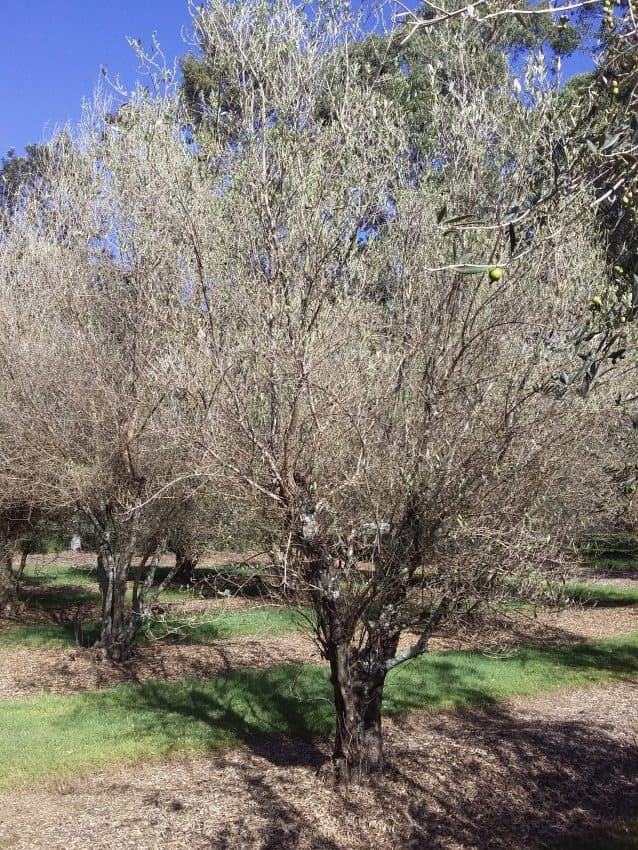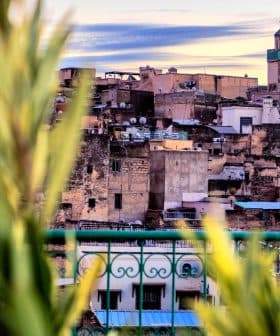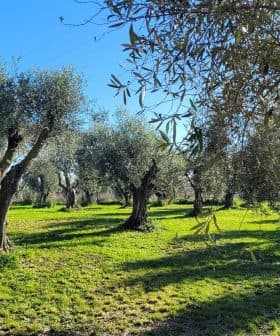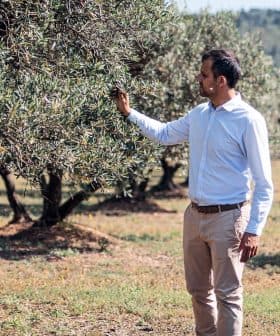Olive Lace Bug Adds to Harvest Woes for Australian Farmers
Wet summers and mild winters have allowed the Australian lace bug to spread from its usual host plants to olive trees across the island.
 (Photo: Denis Crawford / Alamy)
(Photo: Denis Crawford / Alamy) Producers in Australia are facing complications with the olive harvest due to a lace bug infestation that has spread to olive trees from native plants. The infestation has caused severe damage, defoliating trees and affecting olive production for multiple seasons, with preventative measures such as integrated pest management and pesticide applications being recommended to manage the issue.
Producers across Australia anticipate mixed results as the 2024 olive harvest gets underway, with some facing further complications due to a widespread lace bug infestation.
The olive lace bug (Froggattia olivinia) is an Australian native sap-sucking insect that feeds off the underside of leaves. In recent years, the insects have moved from native plants in the olive family to Olea europea, the scientific name for the olive.
We were due for a slow year, but the lace bug infestation has scoured all of our trees… I also expect that the next harvest in 2025 will be poor, as the trees will put their effort into recovery.
“Severe infestations can defoliate trees and even kill young trees,” said Robert Spooner-Hart, an associate professor of applied entomology and crop protection at Western Sydney University.
Spooner-Hart works with the olive industry in Australia and Europe following integrated pest management (IPM) strategies, which use pesticide intervention only when necessary and the least environmentally disruptive methodologies.
See Also:How the Iberian Ant Can Help Control Pests in Olive GrovesWhile olive lace bugs have been reported in olive groves in South Africa, Pakistan and northern India, Spooner-Hart said the one in Australia is a different species.
“Our species originates from the eastern states of New South Wales and Queensland but has now spread to all olive-producing states, mainly through movement of infested plants,” Spooner-Hart said, with the pest reported in Victoria, South Australia, Western Australia and Tasmania.
“It is regarded as the major olive insect pest in Australia,” he added, since the olive fruit fly, olive moth and olive thrips are not present on the island. “Olive black scale is a common but less important pest,” Spooner-Hart said.
Based on a recent conversation with a grower in northern Victoria, Spooner-Hart added that “it’s clear there that olive lace bugs have also utilized ash (Fraxinus excelsior, also in the olive family Oleaceae) as a host.”
Amanda Bailey, a committee member of the Australian Olive Oil Association, confirmed that the olive lace bug has been an issue this season.
“New infestations occur regularly throughout the growing season,” she said. “In extreme cases, some groves have defoliated trees due to olive lace bugs.”

Abandoned grove with severe lace bug damage. (Photo: Robert Spooner-Hart)
She added that the stress and damage to trees caused by olive lace bugs could shock the plant out of production for two to three seasons and even longer if the trees are left untreated.
Bailey said conditions have been perfect for olive lace bugs this season. “In some areas, rain has prevented growers from attending to the issue because the ground has been too boggy to get equipment into the groves,” she explained.
Meanwhile, Ian Buchanan, the owner of Jandra Olive Farm near Eurobin in Victoria, told Olive Oil Times his farm has effectively lost its crop this year.
“We were due for a slow year – we have had three good harvests in a row – but the lace bug infestation has scoured all of our trees,” he said.
“From past experience, this means that even though there are still olives visible on leafless trees, they will no longer accumulate oil,” Buchanan explained. “I also expect that the next harvest in 2025 will be poor, as the trees will put their effort into recovery. The 2026 harvest might be spectacular, but that’s a long way away from now.”
As a result of the infestation, Buchanan planned to purchase an entire crop of olives to mill this year “to keep the business running.”
However, the olive lace bug infested the grove where he would have purchased the olives, and he expected they would also lose their crop.
To his knowledge, Buchanan believes Jandra is located within a 1,000 square kilometer area where most olive groves are entirely infested. “It could well be more extensive than that, but I haven’t seen additional media coverage on it,” he said. “I know it is bad in Western Australia.”
Buchanan followed the usual preventative measures to ward off olive lace bugs, but he said the insects behaved differently this time of year and managed to survive.
“We are normally competent at managing the olive lace bug,” he explained. “We deal with it in small outbreaks every year.”
He said the best practice is spot spraying, which he usually does in an open vehicle with a small tank.
“My eye is trained to spot a cluster from a moving vehicle,” he said. “We only have 750 trees, so one person can deal with it. We also usually see it first on sentinel trees (monitored for the early detection of harmful insects) on the perimeter.”

Olive leaves damaged by the olive lace bug (Photo: Robert Spooner-Hart)
But now things have changed.
“This year, the outbreaks were in the middle of my paddocks, indicating the bugs have successfully overwintered,” he said. “Normally, we are too cold for the olive lace bug to survive winter; it’s originally from the warmer north. In fact, this winter, we had frostbitten olives for the first time in ten years; it was unusually cold.”
Buchanan said this suggests that these bugs have adapted to the cold. “I think it is also fueled by the unusually humid summer we have had. The humidity has been tough,” he said.
After spot spraying in the spring, Buchanan did so again in January before hiring a company to blast spray the entire grove twice.
“We definitely killed a lot of the bugs, but they regenerated again,” he said. “In effect, all I have succeeded in doing was delaying the end result by a few weeks.”
Buchanan also observed the presence of the olive lace bug in mature ash trees around the region.
“You can drive around and see olive lace bugs in them. While olive grove owners might be interested in managing these bugs, public trees in parks and on the side of the road won’t be,” he said. “So it is difficult to contain.”
He added that another complicating factor is that owners of ornamental olive trees and hobby farmers may not notice the infestations, proving a haven for the lace bugs and making outbreaks difficult to prevent.
“Near me are three such groves, all heavily infested with olive lace bugs every year,” Buchanan said. “Inevitably, some of those outbreaks blow my way.”
According to Spooner-Hart, two main climatic conditions influence the spread of the lace bug.
“Hot, dry conditions cause high mortality in the young nymphal instars (the developmental stage between a pupa and an adult insect), especially in the crawlers (newly hatched insects),” he said. “Conversely, mild and humid conditions result in high survival rates to adulthood.”
“Dry conditions, especially in non-irrigated crops, mean trees are more stressed and less able to tolerate damage from bugs,” Spooner-Hart added.
Two years of La Niña during the 2021/22 and 2022/23 crop years in Eastern Australia, followed by an unusual El Niño in which the climate has behaved more like it does during La Niña, may also contribute to the spread of the insects.
“We have had conditions suitable for bug survival and buildup of infestations,” Spooner-Hart said. “Milder winters also probably assist in increasing the number of overwintering adults and even the development of eggs during this time.”
During the warmer winter, many trees did not lose all their leaves, allowing more nymphs to survive.
“Over the past two years, several locations, particularly in eastern Australia, have reported heavy bug infestations,” Spooner-Hart said. “This is probably due to a combination of these conditions.”
Spooner-Hart recommends regularly monitoring groves beginning in mid-spring to detect the emergence of the first cohort of lace bugs. There usually are three cohorts in a season.
This is critical in the management plan. “They are most vulnerable at this time as crawlers (young nymphs) and don’t travel, remaining in gregarious clusters,” Spooner-Hart said. “Originally, infestations start in hot spots, which can be managed.”
The other strategy is effectively timed pesticide applications targeted at newly emerging nymphs in the first cohort.
“A number [of pesticides] are registered in Australia for olive lace bug, including organic options such as potassium soaps and others designed to fit into IPM programs,” Spooner-Hart said.
“We have substantial evidence that one or two well-timed applications are highly effective for one or more seasons,” he added. “They are not highly disruptive to the ecosystem and are unlikely to result in pesticide resistance problems.”
Pruning the trees to create a more open canopy is another strategy for removing olive lace bugs in small groves, particularly if the hot spots are contained.
Buchanan said they have started implementing some changes in their operations to become more resistant to the olive lace bug. Along with blast spraying at the start of spring, he is also running some predator insect trials.
While the spread of the lace bug is well-established in Victoria, Stephen Tham, the co-owner of Cape Schanck Olive Estate on the southern Mornington Peninsula, said the pests had not yet reached their groves.
“Biosecurity by restricting visitors to the grove is the main line of defense,” he said. “The olive lace bug potentially spreads widely through the infected leaves and other plant material of visitors and farmworkers, shared machinery and perhaps contract harvesting and processing.”
“We stopped having contract workers the last six years or so and have only our regular farmworkers, and my sister and husband, during harvest and hence have minimized this risk of cross-contamination,” he concluded.
Share this article









